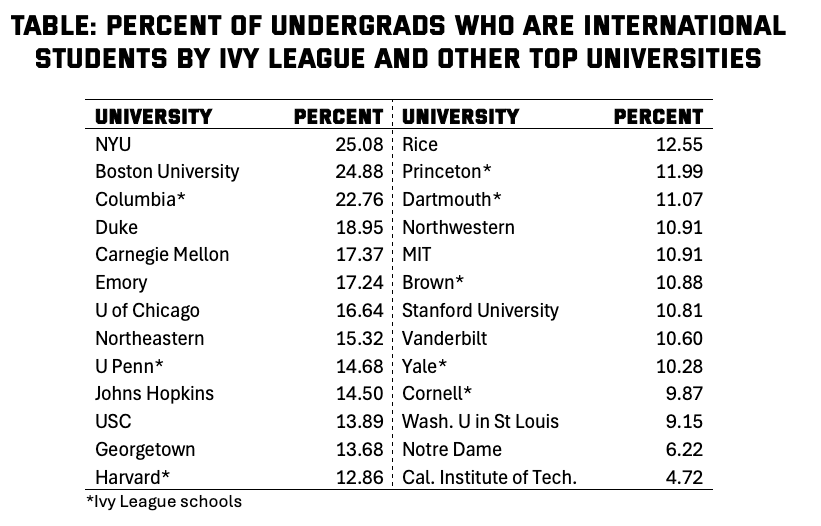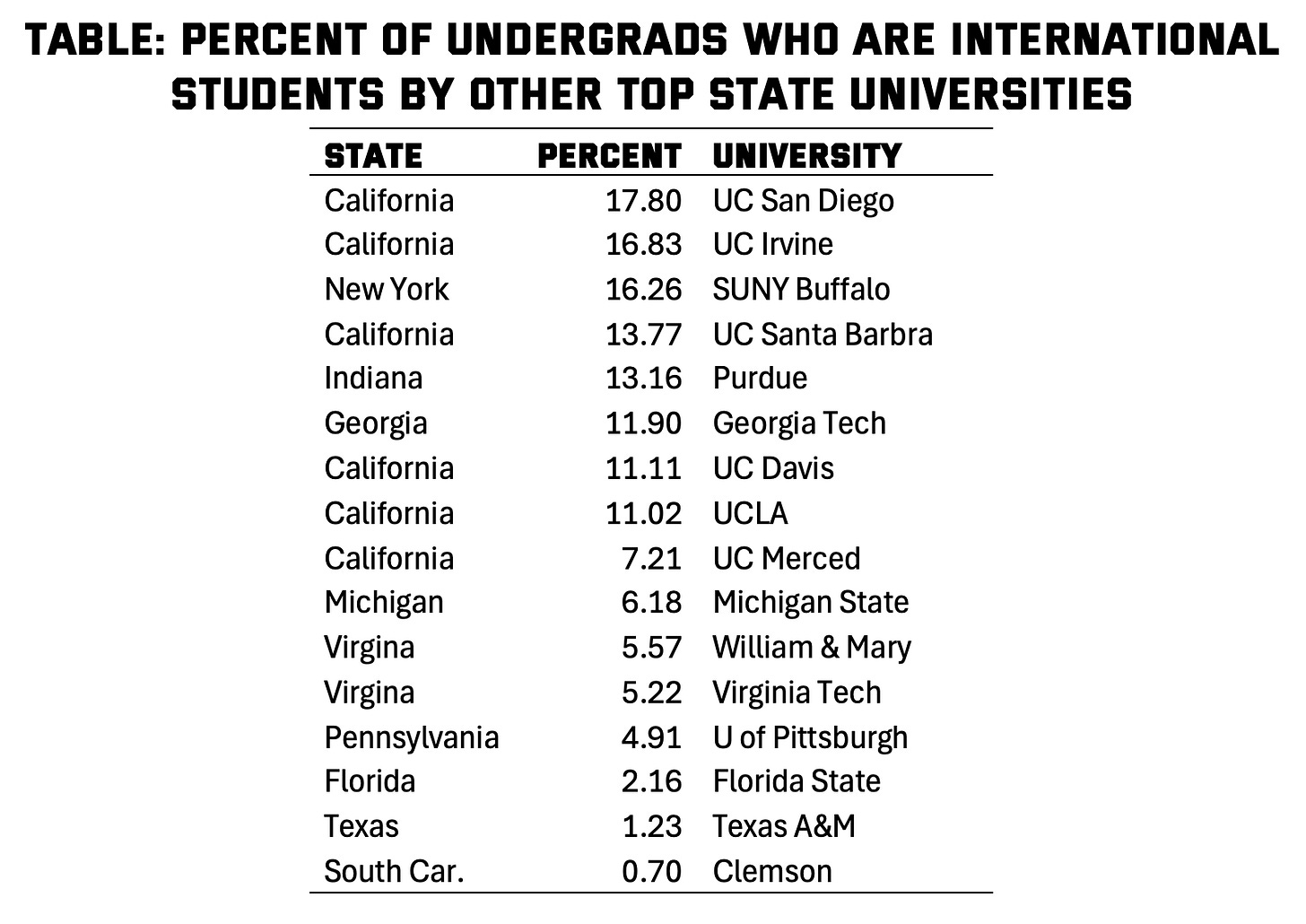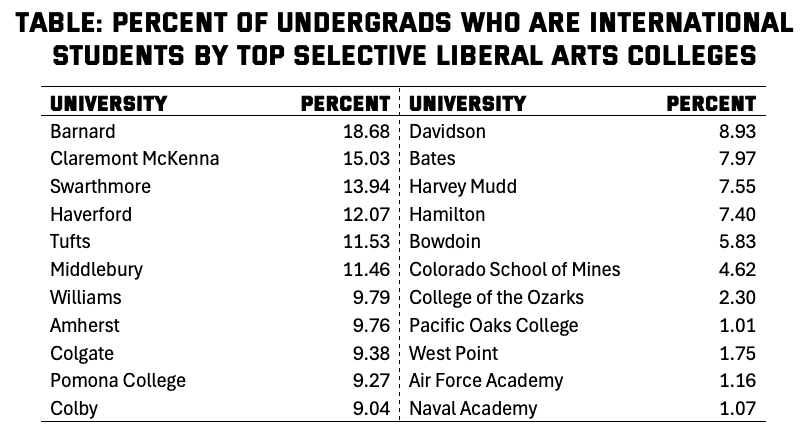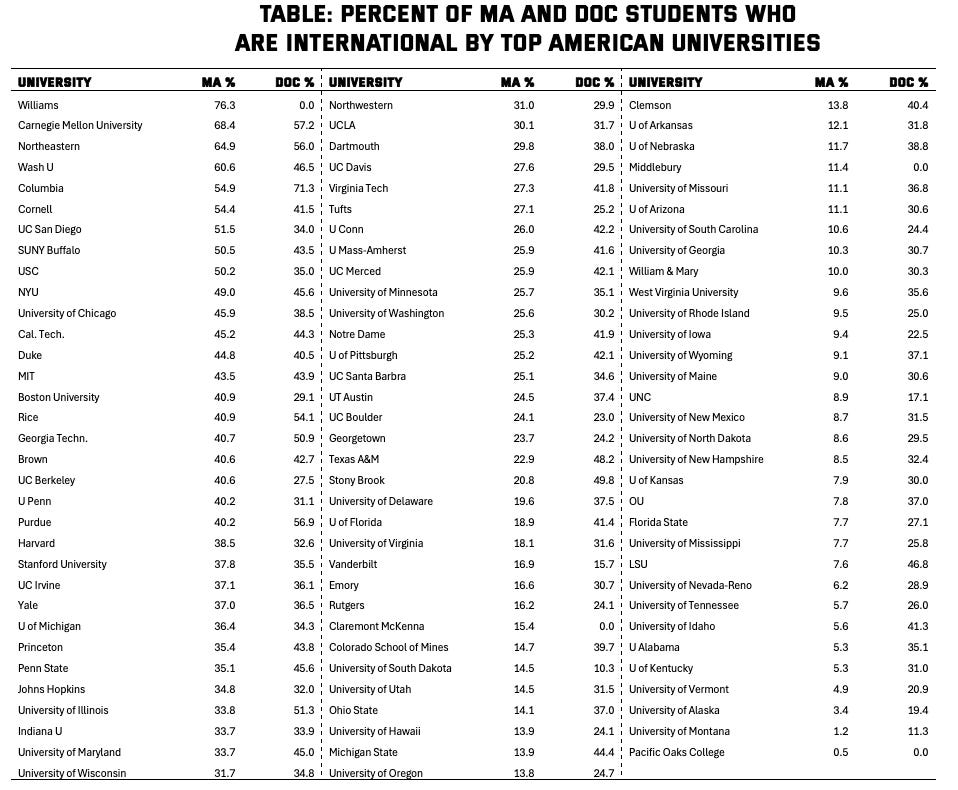No, International Students Are Not Stealing Spots from American Undergraduates
Trump's Compact and other statements have exaggerated concerns over international students at American universities.
President Donald Trump’s administration recently sent an invitation to nine universities for a so-called Compact for Academic Excellence in Higher Education. If joined, it would give these schools extra funding and special treatment, but they would also have to follow specific stipulations set by the White House.
One of the stipulations is that the universities must “cap international undergrad enrollment at 15%,” according to The Wall Street Journal, among other demands
This stipulation is part of a recent trend where international students are being accused of stealing seats from American students at our top universities. “It’s bad for the American dream for a lot of kids who want to go to a nice university and can’t because their spot was taken by a foreign student,” said Vice President JD Vance. “It’s certainly something we’re looking at.”
The argument is not just coming from the Trump administration; it is a broader sentiment that can be heard at the local level as well. For instance, a state representative from New Hampshire has accused the state’s public universities of denying entry to local students and replacing them with international students.
These complaints and recent targets by Trump have specifically been about undergraduate spots going to international students. However, reports of international student numbers are often listed as a total percentage of the university student population. But this percentage is skewed by international graduate students.
In my analysis here, I disaggregated international graduate enrollment from undergraduate enrollment. I show that most top universities are already well below the Trump-suggested threshold for undergrads.
For instance, I found that every university Trump invited to the Compact is already below the 15% international undergraduate threshold:
University of Arizona - 5.6%
Brown University - 10.9%
Dartmouth College - 11.1%
Massachusetts Institute of Technology (MIT) - 10.9%
University of Pennsylvania (U Penn) - 14.7%
University of Southern California (USC) - 13.9%
University of Texas at Austin - 3.8%
University of Virginia - 4.4%
Vanderbilt University - 10.6%
Data on Enrollment and International Students
Note: Skip this section if you just want the results and aren’t interested in the data.
IPEDS data offers a demographic breakdown of all students who graduate by degree (data that universities must submit to the federal government for compliance purposes). This Completion data shows the number of non-resident graduates by Bachelor’s, Master’s, and Doctoral research (I left out other smaller categories of degrees1).
In the “Race/ethnicity” data, IPEDS lists “U.S. Nonresident” for these three categories. This is how the federal government collects this information. So, for instance, a student from China isn’t under Asian, nor is a student from Mexico under Hispanic. Instead, they are both listed as U.S. Nonresident, at least for this federal IPEDS data.
Using the Completion data in IPEDS from the latest academic year (2022-2023), I was able to calculate the percentage of international students for 114 of the top universities in the country. I broke this down by Ivy League, every state flagship university, and all universities or colleges with overall undergraduate acceptance rates below 15%. This should cover basically all elite universities in the country.
I should add that the Completion data actually inflates the percentage of international students a bit, as these students generally have higher graduation rates than their domestic peers. Even with this inflation, the overall average for international undergraduate students at these 114 institutions was just 8.2%.
Ivy League Plus: Not as Many International Undergrads as You Might Think
Despite just being a football conference, the Ivy League holds a special place in American popular consciousness of higher education. Happenings at these eight schools dominate the news about the sector. Certainly, the Ivys do offer pathways into elite echelons of society, so the competition to get into these schools is fierce and contentious. The admit rate for every Ivy League school is below 10%.
Likewise, other universities like Stanford, Duke, and the University of Chicago have also reached similar mythical status. Sometimes these places are referred to as “Ivy Plus,” and I broadened the scope to include other large elite research universities in this section.
Looking at the Ivy League, only one university did not meet Trump’s threshold of less than 15% international students. Columbia was roughly 23% international undergraduates, according to IPEDS data on Completions.
Columbia has had potentially the most contentious relationship with the Trump White House, being the first university targeted. A deal struck between the university and the President explicitly states that Columbia should “[reduce] financial dependence on overwhelming international student enrollment.”
However, Columbia is an outlier among the Ivy League. The other seven institutions were below the undergraduate threshold. U Penn was the closest at just under 15%. The rest hovered a little above and below roughly 10%. Trump’s other favorite university sparing partner, Harvard, was not even at 13%.
Likewise, the other selected Ivy Plus institutions were mostly well under the 15% Trump cap. These private institutions certainly relied more on international students than their public peers, but places like Wash. U in St Louis (9.15%), Notre Dame (6.22%), and California Institute of Technology (4.72%) were even below 10% for their international undergraduates.
However, there were a few that could join Columbia due to higher international undergraduate populations. Both NYU and Boston University had about 25% international undergraduate student bodies. Duke (18.95%), Carnegie Mellon (17.37%), Emory (17.24%), University of Chicago (16.64%), and Northeastern (15.32%) were also over the threshold.
In the end, these elite institutions just do not collectively have an overreliance on international student undergraduates as the narrative would suggest. Even a place like USC, where I was expecting a high international undergraduate count, sat at just 13.89%. Most of these top institutions were simply lower than Trump’s threshold already.
State Flagships Don’t Rely on International Undergrads
State flagship universities are important institutions for every state. They are not only the leading public universities, but also strong symbols for the entire state, especially the football teams. State tax dollars are the key funders for these institutions, so it makes sense that locals would be invested in the student populations at flagship universities.
It turns out that for undergraduate education, international students do not make up a large portion of flagship student bodies. The average percent of international students attending these flagships was just over 5%. Only the state of Washington was over the 15% Trump cap, with the University of Washington at just 15.47%. However, the number would likely be below the cap when factoring in that international students have a 4% higher graduation rate than the total student body, according to IPEDS data.
In total, there were only seven state flagships even above 10% international undergraduates: University of Illinois (14.65%), Stony Brook in New York (14.28%), University of California-Berkeley (14.06%), Penn State (13.32%), University of Wisconsin (10.92%), and University of Michigan (10.57%).
It should be noted that some states already have a cap on non-local students, meaning most seats need to go to students from the state. Texas reserves 90% of its enrollment to in-state students, which equates to a functional cap of 10%. Likewise, both California and North Carolina have a limit of 18% for their flagships. These restrictions are not specifically targeted at international students, but the population is impacted by the limits nonetheless.
Even without these caps, most states do not have high percentages of international students as undergraduates: 43 states have fewer than 10% and over half the states (32) have under 5%. For instance, the University of New Hampshire was at just 1.6%, meaning the claim by the state representative was widely off.
International Undergrads at Other Top Universities and Colleges
One thing I love about the US higher education sector is that we have an assortment of wonderful institutions across the country. I have already shown the Ivy League Plus and state flagship institutions, but there are more privates and publics offering top education. Few have high rates of international students.
Some states have several flagship-worthy institutions, including multiple with very low acceptance rates of around 15% or lower. The list below highlights those types of institutions.
Only three do not meet Trump’s threshold: UC San Diego (17.8%), UC Irvine (16.83%), and SUNY Buffalo (16.26%), which, again, could be due to graduation rates. The rest of these top state institutions were mostly below 15%, including eight of them below 10%. I triple checked the Clemson numbers since it was so shockingly low! Out of 5,311 undergraduate Completions, only 37 were international.
Aside from other large state institutions, the US has a robust tradition of liberal arts colleges. These tiny institutions are often residential, only offering undergraduate education, and often in a small college town. These liberal arts colleges are the old stereotype of the American college experience.
I have selected some of these liberal arts colleges with very low admission rates to test the narrative of overrepresentation of international students. Since they do not have the same state-bound commitments nor the resources of the massive research institutions, it might seem they would have an overreliance on foreign students.
From my list, once again, I found that most of these institutions were well below Trump’s threshold. Only two were over 15%, Barnard at 18.68%, which is part of Columbia’s constellation of colleges, so it is not surprising, and Claremont McKenna at just over 15%. The rest were well below.
At the very bottom, no surprise, were the US Military Academies, each below 2% international students. But many of the other schools sat below 10% international, such as Williams (9.79%), Harvey Mudd (7.55%), and Colorado School of Mines (4.62%). It would seem that these places simply do not fit the narrative about international students stealing seats.
Scapegoating International Students
There seems to be a sentiment of scapegoating international students for all kinds of issues with higher education (an issue that is global right now). They have even been wrapped up in broader immigration discourse. However, as I have shown in the analysis, they are not taking seats from American undergraduates at our top colleges.
Deporting International Students for Social Media Posts is Un-American
Note: I have been hesitant to talk too much about national politics in College Towns because there is already so much coverage of these issues. I usually try to keep focus on local, smaller issues. But I feel compelled to write this post because I have published on the
There are probably some who believe that any number above 0 is too many international students. But it was Trump, Mr. America First, who set the line of 15%. This threshold is part of “Academic Excellence in Higher Education,” according to Trump’s own policies. So it is reasonable to assume the threshold is a conservative allowance.
There were certainly some institutions over Trump’s 15% undergraduate threshold, but only 14 out of the country’s top 114 universities and colleges. Since most elite universities have already been meeting or exceeding Trump’s expectations here, the concern has clearly been overstated in terms of undergraduate education. International students are simply being scapegoated in this case.
That being said, graduate education is a different story. Of the schools with graduate programs2, about 25% of MA students were international, while over 35% for research doctoral students. For MAs, over half the schools were over a 15% threshold. Almost all, except two, were over this mark for the research doctoral program. Many institutions had well over half of all graduate students as international.
However, universities do often use international students as a funding source, especially in pricey MA programs. In essence, they are not taking a seat from an American, but rather funding one in another part of the university. These MA programs do not have the single-digit admit rates like the undergrads. They can be quite debt-heavy, exacerbating the student loan crisis. The expansion of MA programs, in general, has been a large part of the “Age of Conquest” in US Higher Education.
For PhD programs, American universities are usually competing on the world stage for research. Admission is supposed to be for the best applicants regardless of geographic location. Given that Trump has not set caps on doctoral students in the Compact, it seems even he accedes to this global competition aspect of US doctoral programs.
These graduate programs are skewing the overall numbers of international students at US universities. The numbers listed and reported make it seem like American undergraduates are losing out to applicants abroad, but that is simply not the actual story for most top universities. It is important to disaggregate this data so as not to scapegoat the much-maligned international student population once again.
In particular, I left out anything below a Bachelor’s degree, and also the Doctor’s professional practice and Doctor’s other.
The following institutions did not report any graduate students in the data and have been removed from this part of the analysis: Barnard, Swarthmore, Haverford, Amherst, Colgate, Pomona College, Colby, Davidson, Bates, Harvey Mudd, Hamilton, Bowdoin, College of the Ozarks, West Point, Air Force, and Navy.










Thanks for this helpful article. I just wrote about the "Compact" in my newsletter also: https://darbysaxbe.substack.com/p/shame-if-anything-happened-to-your
Great. Then lower the threshold. America for Americans.